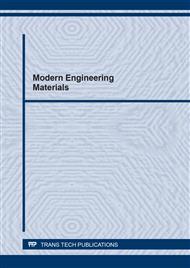p.29
p.35
p.41
p.47
p.55
p.61
p.73
p.81
p.87
Corrosion Resilience of 2101 LDX Duplex Stainless Steels in Varying Sulphate Anion Concentrations
Abstract:
The general and localized corrosion resilience of 2101 LDX duplex stainless steel (2101ST) was assessed in specific concentrations of H2SO4 electrolyte by Potentiodynamic polarization, potentiostatic evaluation, open circuit potential analysis and optical illustration characterization. Data output shows 2010ST exhibited sufficient resistance to general corrosion (0.28 mm/y and 1.01 mm/y) at low concentrations of H2SO4 solution (1M and 2 M H2SO4) whose values correlates to polarization resistance of 42.47 Ω and 19.74 Ω. Further increment in H2SO4 concentration results in substantial increase in degradation rate which culminated at 58.32 mm/y at 6M H2SO4 and polarization resistance of 0.10 Ω. Due to the destructive action of SO42- anions. Corrosion potential shifts indicates dominant anodic dissolution reactions with respect to H2SO4 concentration. Metastable pitting activity was observed on the plot following anodic polarization but prior to passivation of the steel. The metastable pitting current and passivation potential of the steel grew with increase in H2SO4 concentration. This weakened the localized corrosion resistance of the steel at higher H2SO4 solution. This is evident in the decrease in passivation range values plot configuration. Open circuit potential plots depict significant passivation of the steel at 1M H2SO4 solution compared to the plot at 6M H2SO4 which indicates strong tendency to corrode despite its thermodynamic stability. Optical images of 2101ST exterior after corrosion at 1M H2SO4 solution shows mild surface deterioration coupled with miniature corrosion pits. This contrasts the morphology of the steel at 6M H2SO4 which showed the presence of deep and enlarged, corrosion pits, and a badly etched surface showing the grain boundary coupled with a severely degraded exterior.
Info:
Periodical:
Pages:
55-60
Citation:
Online since:
April 2022
Authors:
Keywords:
Price:
Сopyright:
© 2022 Trans Tech Publications Ltd. All Rights Reserved
Share:
Citation:


